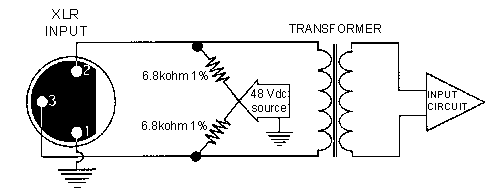Difference between revisions of "Phantom Power"
m |
m (→Phantom Power Connected to Bose Systems) |
||
| Line 48: | Line 48: | ||
You may want to connect your Bose Portable PA to an external system using the Line Out. All of the Line Outputs are line-level, balanced outputs. On the {{T1}}, T4S, T8S, {{Compact}}, the outputs are 1/4 inch (6.3mm). On the T8S, there are also XLR Outputs. | You may want to connect your Bose Portable PA to an external system using the Line Out. All of the Line Outputs are line-level, balanced outputs. On the {{T1}}, T4S, T8S, {{Compact}}, the outputs are 1/4 inch (6.3mm). On the T8S, there are also XLR Outputs. | ||
| + | === Phantom Power - Damage Bose systems? === | ||
;Will phantom power provided by the external system damage the Bose Portable PA system? | ;Will phantom power provided by the external system damage the Bose Portable PA system? | ||
The outputs of Bose Portable PA equipment have circuitry to protect them in case phantom power is turned on in the external system. | The outputs of Bose Portable PA equipment have circuitry to protect them in case phantom power is turned on in the external system. | ||
Revision as of 12:39, 15 January 2019
Contents
Phantom Power Definition
Question: What is a "phantom powered" microphone? Does that mean that the microphone draws its power from a remote source?
Answer: Phantom power is used with condenser microphones. It is called phantom power because there is no obvious external power supply for the condenser mic; the power supply is invisible and therefore a "phantom." The mixer sends voltage up the same wires that the audio is traveling down. Thus, the microphone is receiving the power remotely from the mixer.
Phantom power is a DC voltage (usually 12-48 volts) used to power the electronics of a condenser microphone. For some (non-electret) condensers it may also be used to provide the polarizing voltage for the element itself. This voltage is supplied through the microphone cable by a mixer equipped with phantom power or by some type of in-line external source. The voltage is equal on Pin 2 and Pin 3 of a typical balanced, XLR-type connector. For a 48 volt phantom source, for example, Pin 2 is 48 VDC and Pin 3 is 48 VDC, both with respect to Pin 1 which is ground (shield).
Because the voltage is exactly the same on Pin 2 and Pin 3, phantom power will have no effect on balanced dynamic microphones: no current will flow since there is no voltage difference across the output. In fact, phantom power supplies have current limiting which will prevent damage to a dynamic microphone even if it is shorted or miswired. In general, balanced dynamic microphones can be connected to phantom powered mixer inputs with no problem.
Source: Shure.com
Will Phantom Power Damage Dynamic Microphones
- Phantom power supplies have current limiting which will prevent damage to a dynamic microphone even if it is shorted or miswired. In general, balanced dynamic microphones can be connected to phantom powered mixer inputs with no problem.
Source: Shure.com
Phantom Power Supplied by Bose Systems
Phantom Power Available
On the L1 Classic / L1 Model I the Power Stand supplies 24 volts for Phantom Power.[1]
The T1 ToneMatch Audio Engine provides 48 volts for Phantom Power.[2]
The T4S/T8S ToneMatch® Mixers provide 48 volts for Phantom Power.
Current Limiting
Bose Phantom power supplies have current limiting which will prevent damage to the Bose device if the connected device attempts to draw too much current.
No Phantom Power
There is no phantom available on
Phantom Power Connected to Bose Systems
Applies to:
- ToneMatch Mixers
- L1 Compact
- S1 Pro System
You may want to connect your Bose Portable PA to an external system using the Line Out. All of the Line Outputs are line-level, balanced outputs. On the T1 ToneMatch Audio Engine, T4S, T8S, L1 Compact, the outputs are 1/4 inch (6.3mm). On the T8S, there are also XLR Outputs.
Phantom Power - Damage Bose systems?
- Will phantom power provided by the external system damage the Bose Portable PA system?
The outputs of Bose Portable PA equipment have circuitry to protect them in case phantom power is turned on in the external system.
